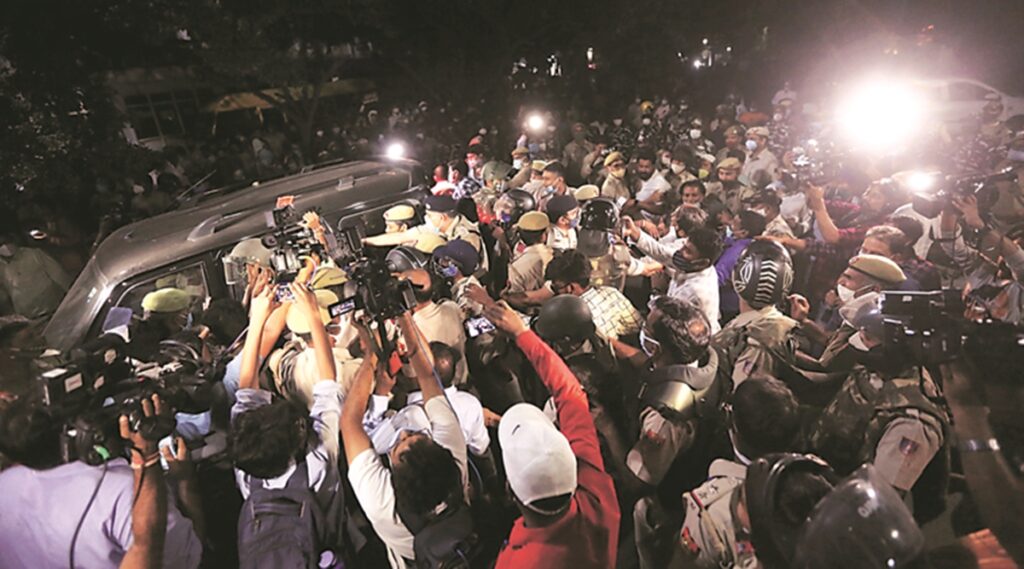Left. One column news on the left. Much brutal than Nirbhaya and Hyderabad rape. But nobody bats an eye. Admit it. We care and protest only when someone who is relatable to us (socially and economically) is getting raped. Someone we could identify ourselves with. Remember the way newspapers and magazines covered the Delhi and Hyderabad incidents ? Still you want us to believe protest have no class or caste? This is HYPOCRISY. Literally Marginalised! Literarily Marginalised!
On the 14th of this month, a 19-year old Dalit girl was strangled, dragged and brutally gang-raped in the field by upper-caste ‘Rajpoot’ men in a village in Hathras of Uttar Pradesh. She had been admitted to the J.N. Medical College Hospital in Aligarh with severe injuries. She was brought to Delhi’s Safdarjung Hospital on Monday after her physical condition displayed no signs of change. She died of her serious injuries on September 29. It’s obvious that a large number of rapes are happening in India and many of them often go unnoticed. Only a few cases gain importance in national and regional media. It’s a bitter truth to admit that not all people of the nation are aware that a 19-year old Dalit girl was brutally gang-raped and died. Maybe it is because the so-called media selectivity and the dramatic value of the crime aren’t high enough to portray the brutalities she faced. Her story appears only in the corners of the national and regional newspaper, that too after her death! The Nirbhaya case has repeatedly been called as the rarest of the rare case and the rape and murder of a 26-year-old veterinary doctor in Hyderabad created a shock-wave across India and quickly gained attention in the Indian media. The cases of Delhi and Hyderabad roused the Indian media and a tempest of news reports followed in the media after the issue. Not only in Indian media but across the world those rape cases captured the headlines in the front page itself.

It is not an amazing factor that the brutal gang rape of this 19-year-old Dalit girl left unnoticed. Not every aspect of the issue was discussed in the regional as well as national media like the sort of rape, the victim, and the perpetrators behind this crime. Neither her story turned into an instance of national importance and significance. The nation or the people in it only sympathise for those who are not marginalised, those who have high profiles or those who are included in a higher social class. Indians are exposed to many different forms of media, such as television, films, documentaries, radio, social media, newspapers, etc. Newspapers have been the predominant medium through which people, in general, gathered data about significant recent developments and issues. Also, Newspaper articles are one of the major media through which most people are exposed to real crimes. Oh yes! Real crimes! Maybe she was not strangled enough or dragged enough! Also, the police have not allowed her family members to take the body back home for the last time and the last rites were forcefully conducted by the police amid strong protests from the family members.
And by influencing the general publics’ opinion and attitudes towards these kinds of matters, media can affect how people react, make decisions and treat perpetrators, victims, and relatives of the victims.
Media have the power to cultivate certain images which influence the manner in which general public interprets issues, events, and encounters. Some stories are frequently told in the mainstream and it is important to note how gang rapes are portrayed in media. Because media are such an important socializing factor and it is important to understand the complexities of the Gang rape and to explore its portrayal and representation of crime, criminals, and victims. Only a few regional newspapers mentioned the name of the accused Sandeep, Ramu, Lavkush and Ravi. Media is the only way through which people are exposed to real crimes. So the medias’ representation of crime, sexual assault and murder affects the general publics’ attitudes and understandings. And by influencing the general publics’ opinion and attitudes towards these kinds of matters, media can affect how people react, make decisions and treat perpetrators, victims, and relatives of the victims.